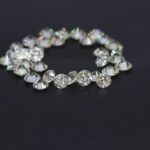Diamond Carat and Size Converter Guide
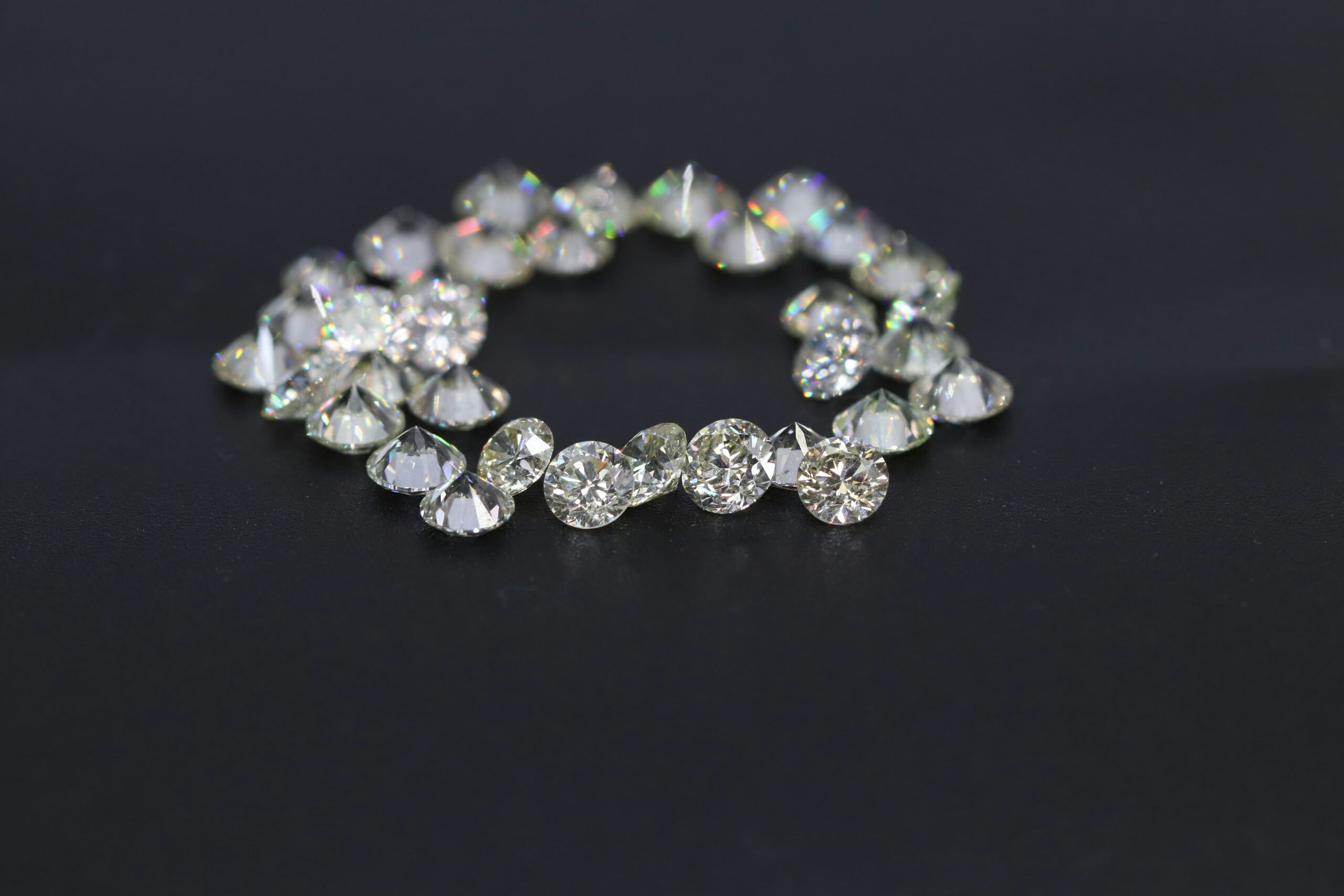
Overview
- How Is Diamond Carat Measured?
- Are Higher Carat Diamonds Larger?
- Comparing Carat Weight Across Various Diamond Shapes and Cuts
- Round Cut Carat Size Converter
- Square Cut Carat Size Converter
- Emerald Cut Carat Size Converter
- Oval Cut Diamond Carat Size Converter
- Pear Cut Diamond Carat Size Converter
- How Much Does Diamond Carat Matter?
There’s a diamond for every wearer. A large, sparkling diamond is the epitome of glamour and a surefire way to attract admiration. A smaller gemstone brings classy brilliance to your look without compromising simplicity.
While an array of different diamonds provides a dazzling sparkle that can’t be ignored. Whatever your personal taste, though, it stands to reason that when purchasing a piece of diamond jewellery, you’ll want to understand the size of the stone you’re buying.
One of the most useful metrics for understanding diamond sizes is the carat. Referring to the weight of the gemstone, carat is one of the all-important four Cs of diamond grading and can have a significant impact on its value.
But does a greater carat weight always mean a visibly larger diamond? This guide, along with our simple carat-to-size conversion table, can help you to understand further.
How Is Diamond Carat Measured?
Carat refers to the weight rather than the dimension of a diamond, with one diamond carat amounting to 0.2g or 200mg of weight. This is measured with extreme accuracy by gemologists using highly sensitive weighing scales, allowing precise measurements to the 100th decimal place. These scales are not only useful for measuring diamond carats but also for telling whether or not a diamond is real.
In addition to the carat weight of a single diamond, a piece of diamond jewellery such as a bracelet or ring can also have a Total Carat Weight (TCW), which is the combined weight of all of the diamonds in the piece.
Are Higher Carat Diamonds Larger?
While you might assume that a diamond of higher carat weight would automatically be larger, this isn’t always the case. Diamonds that have been badly cut, for example, may carry a large amount of weight below the girdle, meaning that they have a much higher carat than they appear to.
Diamonds of different shapes, known as cuts, can also have more or less surface area at the same carat weight. For example, a long fancy cut diamond, such as an emerald cut, might cover more area at a certain carat than a classic round or square cut diamond. This is because round and square-cut diamonds often have a deep pavilion (underside)holding most of their weight.
On the other hand, many fancy-cut diamonds, like emerald, oval, and pear cuts, have shallower pavillions.
Comparing Carat Weight Across Various Diamond Shapes and Cuts
If you’re trying to work out the carat of your diamond from its size, or vice versa, you’ll need to know the cut shape. Then, our helpful diamond carat converter charts below can help you figure out the rest.
Round-Cut Carat Size Converter
A round, brilliant-cut diamond is one of the most popular styles. As the length and width are the same, they are given as one measurement.
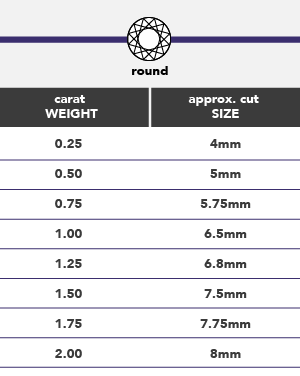
Square-Cut Carat Size Converter
There are two main types of square-cut diamonds: the sharp-edged princess cut and the round-edged cushion cut. These cuts also have deep pavilions and, thus, more weight concentrated into a smaller surface area.
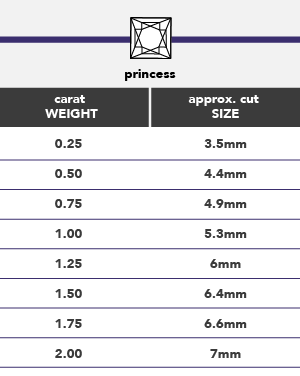
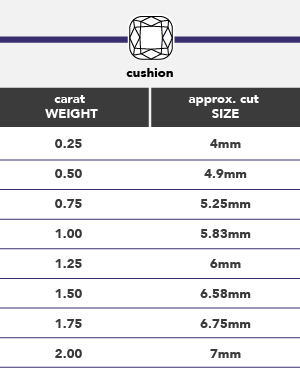
Emerald-Cut Carat Size Converter
As emerald-cut diamonds are rectangular, the length and width are different, so their size is shown as length x width instead of just one measurement for both.
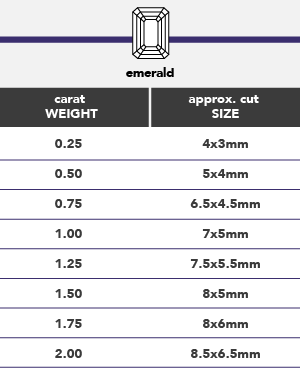
Oval-Cut Diamond Carat Size Converter
Round cuts of diamonds with a greater length than width are known as oval cuts, and they tend to be larger in size per carat due to their greater surface area and shallower pavilion.
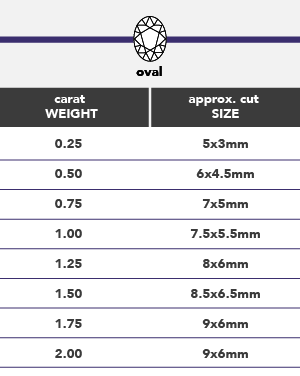
Pear-Cut Diamond Carat Size Converter
Pear-cut diamonds are a type of fancy-cut diamond that has a teardrop shape, being rounded at one end and pointed at the other.
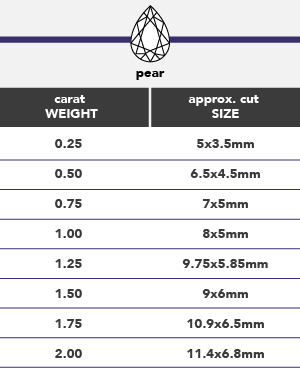
How Much Does Diamond Carat Matter?
Whilst carat is a key metric used for valuing a diamond, as well as being an indicator of size, it’s far from the only thing determining your gemstone’s value. Other factors, such as the cut, clarity and colour of your diamond, have a great influence on its value and beauty.
For example, clarity refers to the number of imperfections, known as inclusions, that your diamond has. You may decide that having a diamond with no visible inclusions is more important than the carat or how large your jewel appears when making your choice.
Cut refers to how your diamond’s surface interacts with and reflects light. Round brilliant diamonds are often prized for their cut quality thanks to their high brilliance (brightness) and fire (how they flash under light), which is why they are an immensely popular style of diamond despite having a smaller surface area in relation to their carat.
You can learn more about the four Cs and their impact on the overall value of your diamond in our guide to the 4 C’s of diamond quality.
In short, how much diamond carat and size matters is down to personal preference and priorities. If you’re buying diamond jewellery for someone else, such as an engagement ring, our engagement ring guide can help you decide on the right carat for your ring, along with other key choices.
Whatever style or carat of diamond you prefer, you can find your perfect piece of diamond jewellery with Hatton Jewellers. Browse our selection of diamond jewellery online, visit us in person at our Chelmsford showroom, or learn more about the jewellery we offer through our blog.


